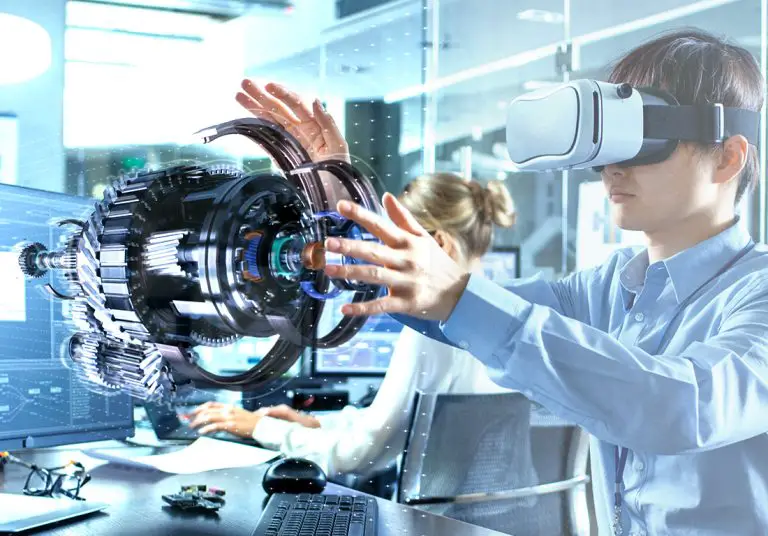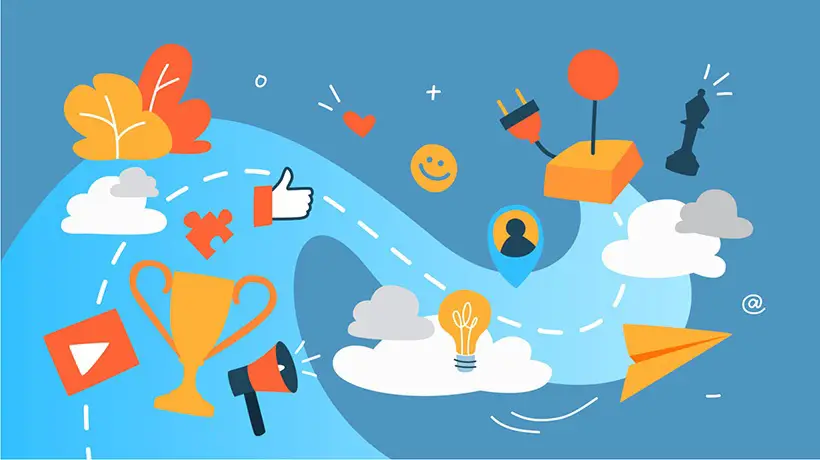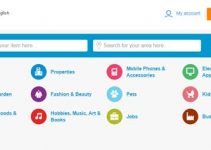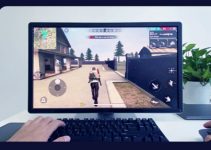EdTech is most commonly associated with online education. But in fact, the concept is much broader. It integrates all the ways technology is used, in the educational process – from interactive school boards to virtual reality simulators that simulate surgical procedures. But learning via the Internet is the most popular EdTech business area, firmly established in the market these days.
Experts define the volume and growth rate of the market in different ways but all agree on one thing – the high estimation of its development prospects around the world.

According to Statista, in 2019, the global online e-learning market was sized at approximately 101 billion U.S. dollars. During that same period, the learning management system market generated roughly 18 billion U.S. dollars. By 2026, the total market for e-learning worldwide is forecasted to grow exponentially, reaching over 370 billion U.S. dollars.
Throughout history, people have constantly been looking for ways to make knowledge transfer easier, faster, and more efficient. The quintessence of this effort in the digital age is EdTech. Today, the market of educational technologies is actively growing around the world (with U.S. and China as market leaders). Modern students no longer consider the process of education without intelligent interfaces, customized programs, and virtual laboratories.
Thanks to innovations, educational content becomes more and more personalized, entertaining, and interactive, which allows them to involve the audience and keep them focused. Let’s see how key technologies help EdTech in this.
Virtual Simulators and Personalization
One of the most visible EdTech trends globally is the shift of focus from mass online courses to personalized training. The popularity of video lectures is explained by the fact that this is the most accessible and inexpensive format. It’s the easiest to implement; however, its effectiveness is not much different from standard university classes.
Gradually, such courses are giving way to products that allow forming individual educational trajectories. These are programs that either adapt to each person’s needs or will enable them to assemble their own learning process.
The first strategy assumes that a student can complete the same course in either two or 125 hours, depending on their pace of learning. The system analyzes the speed of task execution by the student, number of mistakes, and material learning extent, choosing personalized tasks and content presentation order for each student.
The second type of personalized product can be represented by the Dutch lighting manufacturer, Signify (formerly Philips Lighting). Instead of training courses, Signify assigns certification exams to the employees, and they can choose their own way to prepare for these exams.

Analysts predict an up to $6 billion increase in AI spending in the education sector over the next five years. The main growth driver will be China, followed by the U.S. China has traditionally been a leader in introducing AI in any industry. The largest project in education – Squirrel, founded in 2014 by Yixue, today unites more than 1,700 training centers across the country. All of them are based on AI.
The U.S. is trying to keep up with its eastern competitor: the use of artificial intelligence in local education will increase by 48% by 2022 (compared to 2017). One of the most notable players, Carnegie Learning, has received four national awards for its educational products, including the MATHia platform, which uses personalization and inclusion tools to teach students math.
Big Data
Of course, personalization in EdTech is impossible without Big Data and AI, which is widely used in educational products: to analyze student behaviour, create learning algorithms, and check homework. In 2016, students of Georgia Institute of Technology worked for five months with Jill Watson, a faculty member, to help them prepare their papers on a training forum. Only after almost six months of communication with Jill, students learn about the fact that she is not a real person, but an artificial intelligence system based on IBM Watson.
Since March 2019, Belgian schools have been using the British AI-based training platform Century Tech. The system analyzes students’ interests, knowledge skills and gaps, offering unique content based on this data. Similar projects exist in China or Australia.
The education industry deals with a vast amount of data, including information about students, their performance, behavior, and exam results. They help administrators, teachers, and students track progress and identify common trends. Teachers use the data to make personalized lesson plans, predict learning outcomes, and even help students find specializations that best suit their interests and skills.
For example, the Apex Learning platform creates digital learning solutions that allow students to track their progress throughout the semester. Teachers have access to real-time data and updated information to develop or adapt lesson plans to their students’ needs. Another example is the Knowre, which analyzes progress, identifies a particular student’s strengths and weaknesses, and generates appropriate task sets.
Then there’s also secretive and scalable Miro that takes modern education and working with data to the next level. Teachers can use it both synchronously and asynchronously to provide quick feedback on students’ work, improving their approaches. This real-time board is also useful for product development – with it, you can visually collaborate anytime anywhere across your company.
Subscription-Based Education
This new online education format gets more and more popular every year. With classical online education, you purchase a separate course, view it, complete assignments, receive feedback (if available), and receive a course completion document.
At the beginning or in the middle of the course, you may suddenly realize that you are not interested in the program or even the whole subject itself. However, you have already paid for the course, or hired someone from an eLearning software development company and it can’t be cancelled (in rare cases, they offer a refund guarantee) – this is when subscription-based education is the solution.
You can change your courses any time, stop learning, return to previous lessons, move to the next class, complete or skip tasks, etc. During the subscription period, you will have access to all the materials on the platform, and sometimes to all new courses. You can study everything you like at a convenient pace, without having to overpay for your courses.
Gamification
Gamification is one of the most effective tools for engaging students in the educational process. With its help, you can turn any course into an exciting journey. This technique has been widely used for about 20 years, and these days, it starts to be applied almost everywhere.
The most famous example is Duolingo, which congratulates its users every time they achieve their daily goals. There’s also Kahoot, a game-learning platform that allows you to use various quizzes and study most entertainingly.

Why does it work? Learning is hard, and playing is easy and fun. Thus, you only have to combine the pleasant with the useful. With gamification, students get strong emotions, which improves their memory. Games reveal people from the new side, help to aspire to knowledge, and even increase self-esteem.
How to turn a lesson into a game? The recipe is simple: there are tasks and points, which the students get for completing the tasks. Make the points available to the public – and you get a rating system, which results in gamification.
Customize the tasks’ complexity and consider it in your final scores, and voila – the quest is ready. Of course, such a gamification form is far from perfect. It has no plot or goals, no role distribution or different world rules/tests, etc. After all, even the standard school rating system is also partly a game. But it’s not enough for involvement.
When creating a game world, remember common mistakes:
- First, it’s not purely about the competition – your task is education, not sport. The competition serves only as an intrigue, used to immerse students in the process.
- Secondly, do not overdo the awards. They should be valuable, i.e. not expensive but rare. Only those whose achievements cannot be denied deserve awards. Otherwise, they will be devalued, and the gameplay will lose its sense.
- Third, do not go too far with the game itself. Gamification is used for training, not for the game.
And finally, think over the game mechanics – every student should have a real opportunity to get an award.
New Interfaces
The main task of the modern interface is to involve a student in the educational process and provide feedback from the system. If for more “mature” students, the interface plays an insignificant role because they know how to extract information from different formats, then for Generation Z (or homelanders, or centennials, or Net Generation), the interactive interface is often one of the decisive factors in choosing a course.
Interactive interfaces help control students’ progress, get help in learning some topics, etc. Within a manual, an interface can structure material for better understanding. For example, you can break down a textbook and use cards, chapter summaries, small practical assignments, and tests.
Voice Assistants
AI allows you to adapt and personalize learning for each individual student to a certain degree. Hyper personalization is the custom eLearning development of a personal learning profile and the adaptation of materials for each student according to their abilities, preferred learning method, and experience.
E-assistants are already part of our lives – we actively use Siri (Apple), Alexa (Amazon), Cortana (Microsoft), and Google Assistant. But few people pay attention to the role and potential of voice assistants in education. They can increase involvement, create multi-level opportunities for learning, and much more. Even primitive tasks such as setting a reminder or timer, issuing instructions or consulting, etc. – can be implemented with the help of a virtual assistant.
An example is Amazon Alexa at the University of Arizona. The system base contains answers to more than 5 thousand different questions, which allows you to consult first-year students, replacing the traditional printed materials, websites, etc.
Personalization
We are all different; thus, we learn at different speeds. In a simple school program, some students may get bored with their lessons, while others may not keep up with everyone. AI allows us to adapt to learning for each student individually.
The perfect solution is a customized individual learning profile and adapted materials, based on the abilities, the current level of knowledge, and preferred learning method. Once again, Century Tech (British AI platform) can be a great example. It can analyze students’ interests, knowledge levels and gaps, compare data and develop an individualized training program based on it.
VR & AR Technology
From other technological trends in education, VR and AR tools are becoming increasingly important. Virtual reality is turning passive observers into active participants in events that can interact with the educational environment. So far, these technologies are most often used by corporations to educate their employees: universities and schools can’t always afford such a solution.
Immersive learning formats are becoming a global trend. The AR/VR technology market will reach $18.8 billion this year (a three-fold increase over a five-year period), and a significant proportion of solutions are education-oriented. ABI Research predicts that by 2022, the global market for corporate training based on VR will reach $6.3 billion.
Virtual simulators are now used in various fields: from industry and medicine to advanced training of sales managers who improve their skills in dialogue with customer samples. AR solutions help Boeing specialists work with wiring in aircraft, and BMW mechanics to identify and repair vehicle malfunctions.
Little by little, VR and AR technologies are starting to enter the school and student environment. VR Owl, a Dutch company, has developed the TeachVR platform, which allows you to create virtual biology, history, and geography lessons. In many countries of the world, they now plan to implement such solutions in pilot educational institutions.
The spread of AR/VR technologies is also facilitated by the fact that they are becoming more and more available.
The technology is used to attract students to geography, history, or literature, offering a deep immersion in the atmosphere of place and time – instead of reading about Rome, you can go to Rome! Google Expeditions is one of the smartphone apps that allows you to gain this experience. It’s a library of VR excursions – from the Great Wall of China to Mars.
In the virtual medical laboratory, you can conduct experiments without fear of consequences. Medical students, who study anatomy, can better understand the body’s structure and the interconnection of its systems in 3D. For example, students of Mendel gymnasium in the Czech town of Opava study anatomy in biology classes with the help of Leap Motion controller and specially adapted Oculus Rift headsets.
Virtual reality empowers students with special developmental needs. Many people with autism consider 360-degree sensory immersion (video complete with sound through headphones) a convenient and safe way to learn new situations. At the same time, they can easily get themselves out of the simulation if necessary.
Immersive formats have also found application in corporate training. The British startup VirtualSpeech, founded in 2016, is designed to develop soft skills and simulate many situations, e.g. negotiating with a “difficult” interlocutor or performing on stage in front of a vast audience.
In the world, VR is widely used to train employees in potentially hazardous industries such as upstream and downstream industries. The VR Professionals platform creates 3D simulations of real objects (e.g. a ship or even an oil station) or extreme conditions (e.g. an explosion or fire). Augmented Reality is more suitable for visualization of routine operations – for example, it demonstrates the instructions for equipment assembly.
Conclusion
If we talk about the most promising educational segments in EdTech, first of all, it’s primary and high-school education, corporate training, foreign language learning, and tutoring/coaching. Online technologies are actively used in schools and universities. The opportunity to study thoroughly online with a public diploma is offered by most U.S. colleges and universities, among which are the universities of Pennsylvania and Indiana, as well as Boston University.
In the near future, technologies such as AI, big data, and virtual reality will be part of education at all levels. This will happen as the classical education system is integrated with modern digital platforms.






